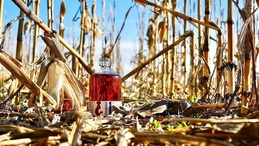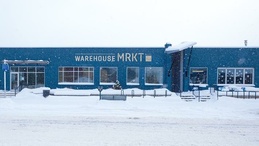
Grow Your Own Morels?
Three MSU scientists are on track to make the seemingly impossible possible
By Craig Manning | April 24, 2021
Hunting for morel mushrooms is a springtime tradition in northern Michigan — especially Up North. But what if you could take this elusive, beloved genus of wild mushroom and grow it yourself, at home?
The party line, historically, has been that cultivating morel mushrooms is impossible. Try reading a few “grow your own mushrooms” guides online, and you’ll likely see the idea of growing morels dismissed out of hand. Even the types of mushrooms that can be cultivated and grown at home or on the farm — from portobellos to white button mushrooms — aren’t exactly easy to grow. According to Better Homes & Gardens, many mushrooms have some pretty particular (and sometimes pretty bizarre) growing needs: oyster mushrooms need to be grown on straw, and white button mushrooms need to be grown on … composted manure.
While cultivating mushrooms isn’t the easiest grow-at-home project in the world, it isn’t impossible. In fact, it might even be possible to grow your own morels.
That’s the prospect that a trio of researchers at Michigan State University (MSU) is chasing with a currently-in-progress three-year study. Gregory Bonito, Trey Malone, and Scott Swinton — all professors at MSU — received a $199,993 grant from the United States Department of Agriculture (USDA) in 2019 to launch the research project, titled “Cultivating a Morel Mushroom Industry in the North Central United States.”
“Recent discoveries on morel mating systems and exogenous nutrition have led to breakthroughs in morel cultivation in China, resulting in thousands of hectares of morel cultivation in China,” reads the team’s proposal abstract. “These new techniques have not yet been introduced to the United States, but they have the potential to dramatically expand the U.S. domestic market.”
The project aims to test China’s morel cultivation techniques on North American soil, focusing specifically on cultivation of the black morel variety. In addition, the study “will gauge market potential” for a morel cultivation industry in the U.S., touching upon everything from consumer taste tests to break-even numbers for crop yields.
According to Dr. Bonito, the MSU project — which officially launched last year — has eight farmers participating from across Michigan, Wisconsin, Ohio, Indiana, and Illinois. Some of those participants are working to cultivate morels in greenhouses, while others are conducting trials in forest systems.
CRACKING THE CODE
Whether indoor or outdoor, cultivation is a meticulous process with all manner of challenges. How do you ensure that the mushrooms have enough shade to grow? How do you provide the correct levels of moisture and temperature? How do you protect against wind, pests, and other threats? How do you schedule key steps of the timeline, from planting to fruiting, to give the morels the best chance of surviving and thriving? Navigating all these questions, Bonito says, is the main purpose of the study.
“In all those steps, there are issues, just like any type of agriculture,” Bonito said. “There’s pests and other problems that can arise. And so that’s what the research is. What are those variables? What are the important things to do [to make sure the mushrooms grow]? How do you do it across different soil types, different climates?”
In season, morels can command prices of $20 or $30 per pound, if not more. Out of season, those prices often double, with home cooks and restaurants alike eager to get their hands on this widely coveted good. Unsurprisingly, given the low-supply/high-demand nature of the mushroom, the MSU study is not the first time someone has tried to crack the code on morel cultivation. According to Bonito, it wouldn’t be an exaggeration to say that farmers and mycology enthusiasts alike have been trying to grow morels “for hundreds of years.”
In the past decade, though, Bonito says researchers in China have made huge leaps forward in cultivating morels. Now, scientists around the world are trying to adapt those discoveries to suit the “climate and soils and native species” of their countries and regions. MSU is taking a lead role in bringing the concept to America.
Even though scientists in other parts of the world have solved the puzzle of morel cultivation, though, Bonito notes that the knowledge is not widely available. From language barrier challenges to mushroom producers that are treating their morel cultivation tactics as carefully guarded trade secrets, there are hurdles left to clear before morel-growing strategies become accessible to all. One of Bonito’s grand visions is being able to remove those barriers.
“No one has a book [on cultivating morels],” Bonito explained. “There's no formula of ‘Here's how you grow them in Michigan, here's how you can be successful.’ That's what this project is about. It’s trying to make it so, at the end, we can have an MSU Extension bulletin or guide that says ‘Here's how,’ just like there are guides for ‘Here’s how you plant your chard’ or ‘Here’s how you plant your beans.’ Here’s when you prep your soil; here's what you need to do when you’re planting; these are the issues; these are the things to avoid doing. We’re hoping that, at the end of the three years, we’ll be able to say, ‘Okay, these are the things you need to do.’”
THE STATUS REPORT
So where do things stand over a year into the study? The project is nearing its first yields. Participating farmers first planted in 2020 and have been keeping an eye on everything from soil temperatures to the development of mycelia — the vegetative, underground network of a fungus — since. Some farm sites even have “primordia” — or “baby mushrooms” — starting to show, a promising sign of progress. May, which is typically morel month in the Midwest, will ideally bring the project’s first mushroom harvest, as well as some valuable insights about where researchers and growers need to go next.
“With primordia started on some of our sites, we’ve had some success [already],” Bonito said. “But the question is, is it economically feasible? How much production do you get per area planted? Those are the numbers that we need to improve upon. So, we'll see in a minute where we're at, and which farmers did what things right. And then we’ll have two more planting cycles: fall will be the second, and then there’ll be a third [next year].” We’ll check back in.
TWO WILD MUSHROOM FESTS
May isn’t just morel month; it’s mushroom month. And if you’re in northern Michigan, it’s a particularly good time to be in the mycology mood. Not only are our region’s conditions often perfect for mushroom hunting, but there are also two mushroom festivals scheduled for May. And, as of now, both are still on, in spite of the ongoing elephant-in-the-room status of COVID-19. Here’s what you need to know:
Mesick Mushroom Festival
May 7-9
Mesick considers itself “the mushroom capital of the United States” and celebrates that status with this family-friendly weekend festival. Events on the schedule this year include a carnival, softball and cornhole tournaments, an antique car show, a grand parade, a Friday night street fair, a Saturday evening “Glow in the Dark” 5K race, mud bogging, and a variety of contests for mushroom hunters. Learn more at www.mesick-mushroomfest.org.
Boyne City’s National Morel Mushroom Fest
May 15-16
Boyne City is planning on holding a “downscaled” version of its annual morel-centric spring festival. That means several major parts of the festival won’t take place as usual this year, including concerts, mass mushroom hunting events, and “The Taste of Morels,” which has traditionally pitted local restaurants against one another in a contest to come up with the best morel-based dish. Still, local restaurants will be featuring specials and morel dishes as part of the festival, and other events — including an arts and crafts show in Veteran’s Park and a limited “Wine & Dine” at the Deerlake Beach House — will be going forward. Visit bcmorelfestival.com for more information.
SUMMER HUNTING
Morels may be the diamonds of the mushroom world in May, but that doesn’t mean they are the only mushroom worth hunting down this spring, summer, or fall. On the contrary, MSU Extension resources indicate that there are 60,100 mushroom species in the state that are regarded as safe to eat.
The challenge? Those dozens of mushrooms exist among the 2,500-plus species that grow in Michigan, which means that the vast majority of mushrooms you find out in the woods are poisonous and potentially deadly. Complicating matters further is the existence of “lookalike” mushrooms or varieties of mushrooms that resemble popular edible varieties (including morels) but that aren’t safe to eat.
To help amateur mushroom hunters identify true morels — and other varieties of edible mushrooms — the Michigan Department of Natural Resources (DNR) is hosting two wild mushroom clinics, June 6 and July 18, in Cadillac. The clinics are $40 and are limited to 30 participants each. To register for a class, visit michigan.gov/dnrlicenses and click on the "Purchase a license" button. Sign in and find your desired class under the “Outdoor Skills Academy” tab.
Trending

Farm to Glass with Ethanology
When Elk Rapids distillery Ethanology committed to locally-sourced ingredients for their products, it seemed like they&rsquo… Read More >>
MRKT HLDY SHPPNG, aka Warehouse MRKT Holiday Shopping!
Shop the latest from local makers and vendors at the Holiday MRKT Share at Warehouse MRKT in TC, Saturday, Dec. 20, from 10a… Read More >>
Men and Ugly Sweaters
Those two things don’t always go together, but on Dec. 19, you’ll see both out and about in Petoskey and Harbor … Read More >>


